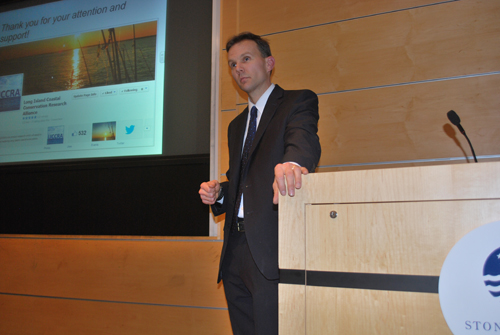SBU marine biologist launches water quality information initiative

Christopher Gobler on Friday summed up the state of Long Island’s bays in two words: “Not great.”
And he said he wants people to know it.
Mr. Gobler, a marine biologist at Stony Brook University, said Friday he will spearhead a new initiative to communicate information about Long Island’s bays to the public.
He said the Long Island Coastal Conservation Research Alliance, or LICCRA, will conduct research and then release information on Facebook, on liccra.org and to media.
“The goal of LICCRA is to both monitor and conduct research on our coastal ecosystems and then rapidly communicate our findings to the public,” he said.
Mr. Gobler unveiled the initiative during a lecture at Stony Brook Southampton in which he summed up the myriad problems his lab and others have seen in bays across Long Island in recent years.
In short: “There was a series of impairments in nearly every water body,” he said, speaking to an audience of about 100 people.
He said harmful algal blooms, some of them toxic to humans and pets, were found across Long Island last year.
Low oxygen and acidification are making some areas more hostile to marine life. Eelgrass, an important part of marine ecosystems, is disappearing. And salt marshes, which help bulwark the shoreline against storm surges, are weakening.
Mr. Gobler said his lab has helped understand the cause of many of the problems: Nitrogen pollution, which travels from underground septic tanks and cesspools, through groundwater and out into the bays. Roughly 360,000 homes in Suffolk County aren’t connected to sewers.
Mr. Gobler praised a recent announcement by Suffolk County Executive Steve Bellone that the county will seek $750 million in state or federal funding to connect roughly 12,000 homes in the county to sewers.
Those homes are along three rivers – the Carlls River, the Connetquot River and the Forge River – that empty into the Great South Bay.
“There’s very positive movement at the county level,” Dr. Gobler said.
But, he said, the East End will probably never have sewers on a large scale. He said homes and businesses on the East End are generally spread too far apart to make sewers financially viable.
Instead, he said, upgrading septic tanks and cesspools with technology that filters out nitrogen could be an option.
LICCRA will replace and expand on the Stony Brook Southampton Coastal and Estuarine Research Program, or SCERP, a previous initiative that Dr. Gobler’s lab started in 2003.
Mr. Gobler said LICCRA will focus on all of Long Island, rather than just the East End, and place a greater emphases on communicating findings to residents.
“The alliance is between the scientists and the public,” he said.
He said he hopes to one day provide real-time data on water quality that could be useful to fisherman.
Despite LICCRA’s broadened mission, the East End will stay play a prominent role in the organization’s research.
For instance, he said, he hopes to examine rust tides in Peconic Bay more closely in the coming year.
In 2012 and 2013, rust tides swept through the bay and appeared to ruin promising scallop seasons, he said.
He said the reddish algae appears to be toxic to shellfish and finfish, and his lab is trying to understand why.
“There could be a direct link, there could be an indirect link, there may be no link,” he said in an interview. “We haven’t connected all the dots.”
Two of his doctoral students, Ryan Wallace and Andrew Griffith, said they hope to use a boat equipped with sensors – and possibly a remote-controlled drone equipped with a camera – to better understand how rust tides move in the Peconic Bay this year.
Mr. Wallace said rust tides appear in irregular patterns across the Peconic and other nearby bays, like Shinnecock Bay. The algae has been appearing in East End bays since about 2004.
“Since this species is so dynamic, you might see it in a patch and in an hour there’s no more red there,” Mr. Wallace said.
That distinguishes it from other harmful algae, like brown tides, which spread out over a broad area, he said.
The rust tide has other strange habits, Mr. Griffith said. It sinks to the bottom of the water at night, then rises to the top during the day as it reacts to light. It also appears to be more toxic at colder temperatures.
“We really want to understand it,” he said.






